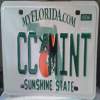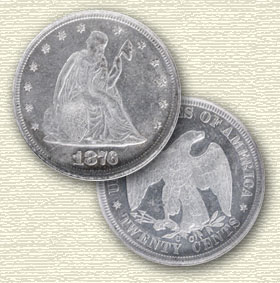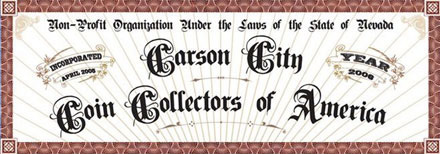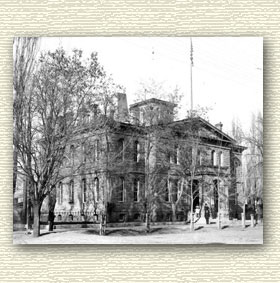- Posts: 176
- Thank you received: 0
1874-CC $20 Gold Carson City Coin of the Week 3/27/11
14 years 7 months ago - 14 years 7 months ago #2368
by randysc
1874-CC $20 Gold Carson City Coin of the Week 3/27/11 was created by randysc
In 1874 people on the East Coast of the United States were experiencing the pains of a critical coin shortage. It was difficult for the Philadilphia Mint to keep up with the demand, so both mints on the West Coast, San Francisco and Carson City, were burning the mid-night oil increasing production with a lot of it going back east to help alleviate the shortage.
Up until 1874, the refining capicity for the Carson City Mint had been 7,000 ounces per day being done being done with two tanks and two furnaces. In early 1874, then superintendent Frank Hetrich doubled the refinery equipment thereby doubling the refining production to 14,000 ounces per day, but was warned by then United States Superintendent of the Mint, Dr. H.R. Linderman to watch his spending and not to go over its budget. At the time Linderman was working to get a deficiency bill passed through Congress for funds to deal with the work overload. Only when the mint shutdown during the annual clean up time in June would the crew get any rest. Hopefully Lindermans bill would ease the overworked crew, but the Mint was producing at near capicity rates, and as long as that demand was called for, its crew kept working to make it happen, producing the needed coinage.
After June's clean up, work picked back up in July with shifts going 24 hours a day. Disgusting, sulphurous fumes bellowed from the Mint's big smoke stack. Residents of the town found the smell quite offensive, so much that those in the north part petitioned Linderman, crying foul, as the smell was, and in the petetion requested that he order a higher chemney to be built. The mint director sent one Professor Jacob Schrimer, who was supposed to be an expert on such matters, to investigate. After a few test (probably the most effective one, done with his nose) he agreed with the citizens of Carson and informed Linderman that there was indeed a problem and the smell was nauseous. Linderman sent the problem to an expert in Philadelphia and several elaborate systems were designed to end the Carson City Mint's problem of the unpleasant odors,but it soon turned out that there were no funds available to deal with it, so the matter was dropped. If the people of Carson City wanted their mint to continue to operate, they would either have to hold their breaths or hold their noses.
In August of 1874, Frank Hetrich resigned as Superintendent of the Carson City Mint and in September James Crawford took the position becoming the mint's fourth superintendent and lasting more that ten years, would be the one who would serve the longest in that position.
1874 was the first year for the Carson City Mint that productions would be over one million coins total, 1,596,067 coins to be exact. It would be the first of a five year run that over a milloin coins a year was produced. With the Trade dollar making for most of the total at 1,373,200, the double eagle came next with 115,085 pieces minted. It was the first time in its five years of operation that double eagle production exceeded 100,000. The closes total prior was in 1872 with only 29,650, so it was quite a jump for the mint. Still the 1874 double eagle production for San Francisco was over ten times as much as Carson City's with 1,214,000 coins, but bearing the fact that Carson City was working with just one coin press and the workers were working long hours as it was, their output was to be appreciated. The 115,085 C.C. double eagles minted in 1874 would end up being the second highest mintage totals for C.C. double eagles. Only 1876 would have higher mintage totals. The survival estimation total is thought to be approximately 2500 pieces, with about 2000 of those believed to be in grades of AU and below. So far as I know, none grade higher that MS-62.
The 1874 double eagle with below average luster, a weakness in striking of the centers on both sides and numerous bag marks, a plague of most Carson City coins, makes for a less that average eye appeal. Pieces with good eye appeal, though are hard pressed to come by, would of course call for higher primiums.
The surface of a typical 1874 C.C. double eagle is found to have deep abrasions on its surface. These coins were put to work, rather it was to satify the need for large denomination gold coins in the West at the time, or to help with the coin shortages back East, they were used and as a result, roughly handled during transportation. It is hard to fine one not excessively bag marked.
The luster of this issue is unusually grainy in likeness, different than any other C.C. double eagle of this period. It is so that many examples are mistken to have had some cleaning, although many have been lightly cleaned or dipped in recent years to bring out a stronger color.
The overall strike of the 1874 C.C. double eagle is not generally sharp. The hair of Liberty behind the ear and above the brow is usually flat, likewise the top of the hair and in the bun although it can be sharper in these areas. It is hit and miss in the definition of the stars, some will have sharp detail while others will be flat. The reverse is sharper but the center again will show weakness.
Price range estimates, and again these are just estimates, not carved in stone, but according to the PCGS website they are as follows:
VF30-$2315 / EF40-$2900 / AU55- $6000 / MS60- $14,500
MS62- $35,000
The 1874 C.C. double eagle is a more common date double eagle as Carson City dates go. For just a slight increase in the premium over the cost of a common date double eagle one can obtain one and have an example of a double eagle from the Carson City Mint. Of course the real challange is the hunt of finding one that has the least amount of marks on the surface, but it will cost and is usually a goal of the more seasoned, serious collector. But having a nice one in a grade of Very Fine grade can be equally as satisfying to have to the budget conscious collector as a mint state one is to the seasoned. Enjoy.
-Randy-
Up until 1874, the refining capicity for the Carson City Mint had been 7,000 ounces per day being done being done with two tanks and two furnaces. In early 1874, then superintendent Frank Hetrich doubled the refinery equipment thereby doubling the refining production to 14,000 ounces per day, but was warned by then United States Superintendent of the Mint, Dr. H.R. Linderman to watch his spending and not to go over its budget. At the time Linderman was working to get a deficiency bill passed through Congress for funds to deal with the work overload. Only when the mint shutdown during the annual clean up time in June would the crew get any rest. Hopefully Lindermans bill would ease the overworked crew, but the Mint was producing at near capicity rates, and as long as that demand was called for, its crew kept working to make it happen, producing the needed coinage.
After June's clean up, work picked back up in July with shifts going 24 hours a day. Disgusting, sulphurous fumes bellowed from the Mint's big smoke stack. Residents of the town found the smell quite offensive, so much that those in the north part petitioned Linderman, crying foul, as the smell was, and in the petetion requested that he order a higher chemney to be built. The mint director sent one Professor Jacob Schrimer, who was supposed to be an expert on such matters, to investigate. After a few test (probably the most effective one, done with his nose) he agreed with the citizens of Carson and informed Linderman that there was indeed a problem and the smell was nauseous. Linderman sent the problem to an expert in Philadelphia and several elaborate systems were designed to end the Carson City Mint's problem of the unpleasant odors,but it soon turned out that there were no funds available to deal with it, so the matter was dropped. If the people of Carson City wanted their mint to continue to operate, they would either have to hold their breaths or hold their noses.
In August of 1874, Frank Hetrich resigned as Superintendent of the Carson City Mint and in September James Crawford took the position becoming the mint's fourth superintendent and lasting more that ten years, would be the one who would serve the longest in that position.
1874 was the first year for the Carson City Mint that productions would be over one million coins total, 1,596,067 coins to be exact. It would be the first of a five year run that over a milloin coins a year was produced. With the Trade dollar making for most of the total at 1,373,200, the double eagle came next with 115,085 pieces minted. It was the first time in its five years of operation that double eagle production exceeded 100,000. The closes total prior was in 1872 with only 29,650, so it was quite a jump for the mint. Still the 1874 double eagle production for San Francisco was over ten times as much as Carson City's with 1,214,000 coins, but bearing the fact that Carson City was working with just one coin press and the workers were working long hours as it was, their output was to be appreciated. The 115,085 C.C. double eagles minted in 1874 would end up being the second highest mintage totals for C.C. double eagles. Only 1876 would have higher mintage totals. The survival estimation total is thought to be approximately 2500 pieces, with about 2000 of those believed to be in grades of AU and below. So far as I know, none grade higher that MS-62.
The 1874 double eagle with below average luster, a weakness in striking of the centers on both sides and numerous bag marks, a plague of most Carson City coins, makes for a less that average eye appeal. Pieces with good eye appeal, though are hard pressed to come by, would of course call for higher primiums.
The surface of a typical 1874 C.C. double eagle is found to have deep abrasions on its surface. These coins were put to work, rather it was to satify the need for large denomination gold coins in the West at the time, or to help with the coin shortages back East, they were used and as a result, roughly handled during transportation. It is hard to fine one not excessively bag marked.
The luster of this issue is unusually grainy in likeness, different than any other C.C. double eagle of this period. It is so that many examples are mistken to have had some cleaning, although many have been lightly cleaned or dipped in recent years to bring out a stronger color.
The overall strike of the 1874 C.C. double eagle is not generally sharp. The hair of Liberty behind the ear and above the brow is usually flat, likewise the top of the hair and in the bun although it can be sharper in these areas. It is hit and miss in the definition of the stars, some will have sharp detail while others will be flat. The reverse is sharper but the center again will show weakness.
Price range estimates, and again these are just estimates, not carved in stone, but according to the PCGS website they are as follows:
VF30-$2315 / EF40-$2900 / AU55- $6000 / MS60- $14,500
MS62- $35,000
The 1874 C.C. double eagle is a more common date double eagle as Carson City dates go. For just a slight increase in the premium over the cost of a common date double eagle one can obtain one and have an example of a double eagle from the Carson City Mint. Of course the real challange is the hunt of finding one that has the least amount of marks on the surface, but it will cost and is usually a goal of the more seasoned, serious collector. But having a nice one in a grade of Very Fine grade can be equally as satisfying to have to the budget conscious collector as a mint state one is to the seasoned. Enjoy.
-Randy-
Last edit: 14 years 7 months ago by randysc.
Please Log in to join the conversation.
14 years 7 months ago - 14 years 7 months ago #2376
by Carsonite
C4OA Lifer!
Replied by Carsonite on topic Re:1874-CC $20 Gold Carson City Coin of the Week 3/27/11
Randy,
You provided a good mix of history, behind-the-scenes background information, and statistics about the 1874-CC double eagle.
You wrote:
You also wrote:
You also did a good job of laying out your article, with nice paragraph spacing.
I can tell you, like the other COWboys, are having a good time submitting these posts.
Rusty
You provided a good mix of history, behind-the-scenes background information, and statistics about the 1874-CC double eagle.
You wrote:
This is an interesting observation: an important milestone in the Carson Mint's history.1874 was the first year for the Carson City Mint that productions would be over one million coins total....
You also wrote:
This comparsion between $20 gold piece production at both western mints puts things in perspective, as does your reference to the Carson Mint's employees working under less favorable conditions than their counterparts at the San Fran. Mint.Still the 1874 double eagle production for San Francisco was over ten times as much as Carson City's with 1,214,000 coins, but bearing the fact that Carson City was working with just one coin press and the workers were working long hours as it was, their output was to be appreciated.
You also did a good job of laying out your article, with nice paragraph spacing.
I can tell you, like the other COWboys, are having a good time submitting these posts.
Rusty
C4OA Lifer!
Last edit: 14 years 7 months ago by Carsonite. Reason: Sizing
Please Log in to join the conversation.
- Loosechange
- Offline
- Platinum Member
-

- Married to my best friend!
Less
More
- Posts: 504
- Thank you received: 0
14 years 7 months ago #2377
by Loosechange
Go "CC'S"
Replied by Loosechange on topic Re:1874-CC $20 Gold Carson City Coin of the Week 3/27/11
Great job Randy! Excellent and informative post. It is amazing that with only the one press that they cranked out as many coins as they did albeit with much longer hours. Only with Carson City do you get a common date with only 115,085 pieces is just mind blowing.
Loosechange
Loosechange
Go "CC'S"
Please Log in to join the conversation.
- deepsouthspike
-

- Offline
- Senior Member
-

Less
More
- Posts: 91
- Thank you received: 0
14 years 7 months ago #2378
by deepsouthspike
Replied by deepsouthspike on topic Re:1874-CC $20 Gold Carson City Coin of the Week 3/27/11
Randy,
I am trying to imagine what the odor must have been like for the residents living near-by to the "CC" Mint. Working for an Airline,I spend a lot of my time above 35,000 feet. This kind of reminds me of how trapped one can feel when buckled in your seat during turbulance while seated next to a lavatory that has just had constant use over the previous several hours on a long haul flight.
Wonder how heavy a Mint bag full of 1874-cc Double Eagles weighed?
Thanks for the enjoyable post!
Tom.....deepsouth
I am trying to imagine what the odor must have been like for the residents living near-by to the "CC" Mint. Working for an Airline,I spend a lot of my time above 35,000 feet. This kind of reminds me of how trapped one can feel when buckled in your seat during turbulance while seated next to a lavatory that has just had constant use over the previous several hours on a long haul flight.
Wonder how heavy a Mint bag full of 1874-cc Double Eagles weighed?
Thanks for the enjoyable post!
Tom.....deepsouth
Please Log in to join the conversation.
14 years 7 months ago #2379
by randysc
Replied by randysc on topic Re:1874-CC $20 Gold Carson City Coin of the Week 3/27/11
Hey Tom-
Very interesting questions you propose. As to the smell, I am in the water treatment business and west of where I live (Central California)in some areas the water has a hydrogen sulfide problem, a sulfuric gas that is in the ground water there. It is not toxic but it gives off an unpleasant odor of rotten eggs. I'm imagining that the sulphurous smell the people of Carson then were smelling could something like a mix of rotten eggs mixed with freshly burned matches. Just a guess.
As for a weight of a mint bag of 1874-CC double eagles, so far as I can find, when minting double eagles, the mint put them in small bags of $500, or 25 coins or most often bags of $5000, or 250 coins. A Liberty double eagle weighed 33.436 grams times 250 coins equals 8359 grams. With about 27 grams in a standard ounce (not a troy ounce) A bag of 250 coins would weigh just under twenty pounds.
-R-
Very interesting questions you propose. As to the smell, I am in the water treatment business and west of where I live (Central California)in some areas the water has a hydrogen sulfide problem, a sulfuric gas that is in the ground water there. It is not toxic but it gives off an unpleasant odor of rotten eggs. I'm imagining that the sulphurous smell the people of Carson then were smelling could something like a mix of rotten eggs mixed with freshly burned matches. Just a guess.
As for a weight of a mint bag of 1874-CC double eagles, so far as I can find, when minting double eagles, the mint put them in small bags of $500, or 25 coins or most often bags of $5000, or 250 coins. A Liberty double eagle weighed 33.436 grams times 250 coins equals 8359 grams. With about 27 grams in a standard ounce (not a troy ounce) A bag of 250 coins would weigh just under twenty pounds.
-R-
Please Log in to join the conversation.
- coindrummer
-

- Offline
- Platinum Member
-

- Michael D. Parrott
Less
More
- Posts: 775
- Thank you received: 0
14 years 7 months ago - 14 years 7 months ago #2380
by coindrummer
C4OA Lifer!
Replied by coindrummer on topic Re:1874-CC $20 Gold Carson City Coin of the Week 3/27/11
Hi Randysc
Thank you for a most informative and well written COW post.
Despite the foul odors that the manufacturing process produced, Carsonites in those days were more than likely very proud and appreciative of their mint and all the wealth it brought to their town.
I'ts hard to believe that a coin with only around 2500 survivors in all grades is considered "common", for "CC" standards,I guess it is!
Just think that only around 2500 people in the whole could possibly be in ownership of one of these rarities! If there was ever a "run" on them, imagine what the prices could climb too.
You wrote:
Of course the real challange is the hunt of finding one that has the least amount of marks on the surface, but it will cost and is usually a goal of the more seasoned, serious collector.
I agree with you. I've seen many 1874-CC double eagles (I even owned a PCGS XF-45 example several years ago), but I've never seen one that I would consider having exemplary eye appeal, not live and in person at least. High condition specimens are hard to come by indeed!
I look forward to more great posts Randy.
the drummer
Thank you for a most informative and well written COW post.
Despite the foul odors that the manufacturing process produced, Carsonites in those days were more than likely very proud and appreciative of their mint and all the wealth it brought to their town.
I'ts hard to believe that a coin with only around 2500 survivors in all grades is considered "common", for "CC" standards,I guess it is!
Just think that only around 2500 people in the whole could possibly be in ownership of one of these rarities! If there was ever a "run" on them, imagine what the prices could climb too.
You wrote:
Of course the real challange is the hunt of finding one that has the least amount of marks on the surface, but it will cost and is usually a goal of the more seasoned, serious collector.
I agree with you. I've seen many 1874-CC double eagles (I even owned a PCGS XF-45 example several years ago), but I've never seen one that I would consider having exemplary eye appeal, not live and in person at least. High condition specimens are hard to come by indeed!
I look forward to more great posts Randy.
the drummer
C4OA Lifer!
Last edit: 14 years 7 months ago by coindrummer.
Please Log in to join the conversation.
Time to create page: 0.119 seconds


